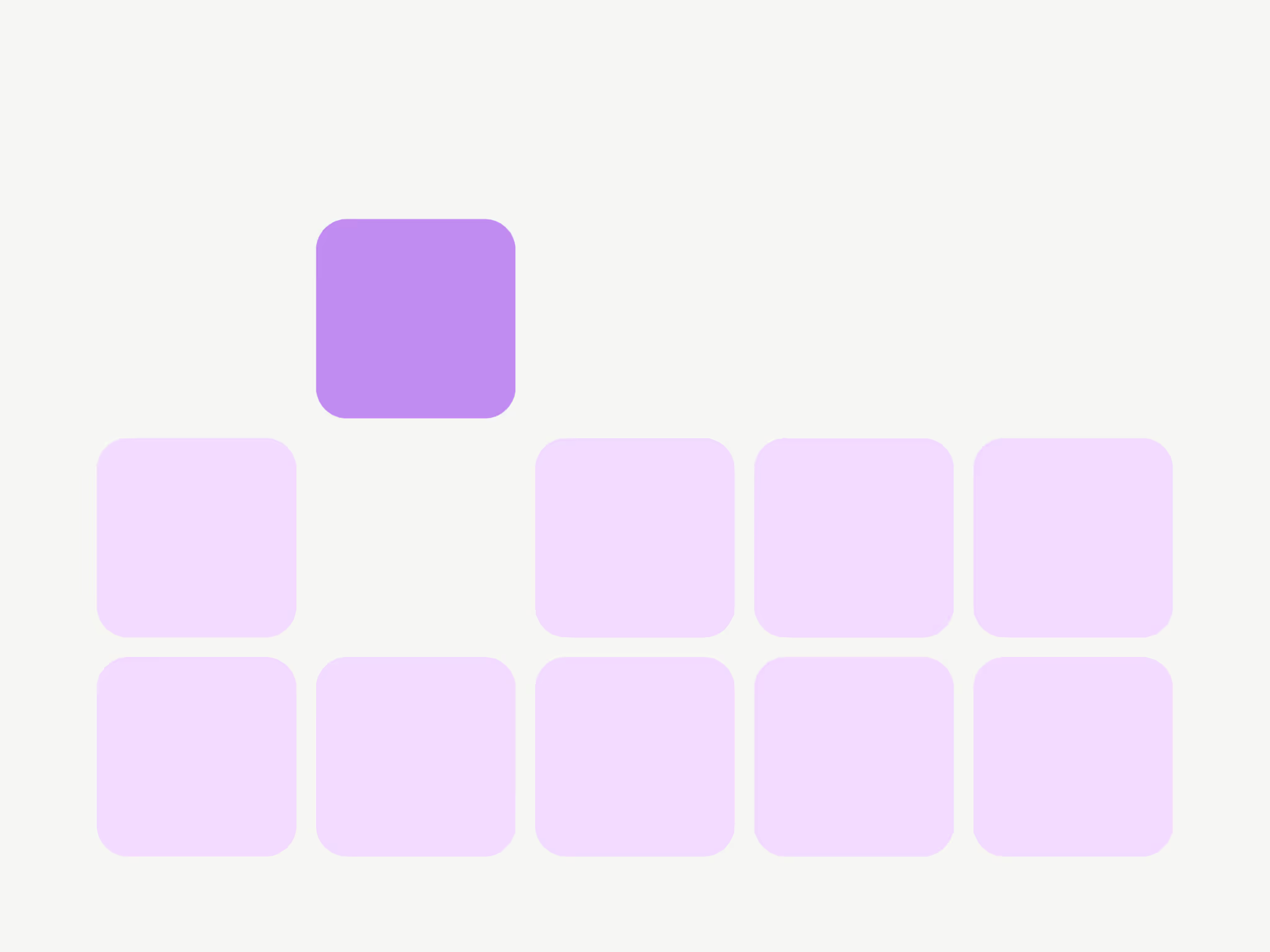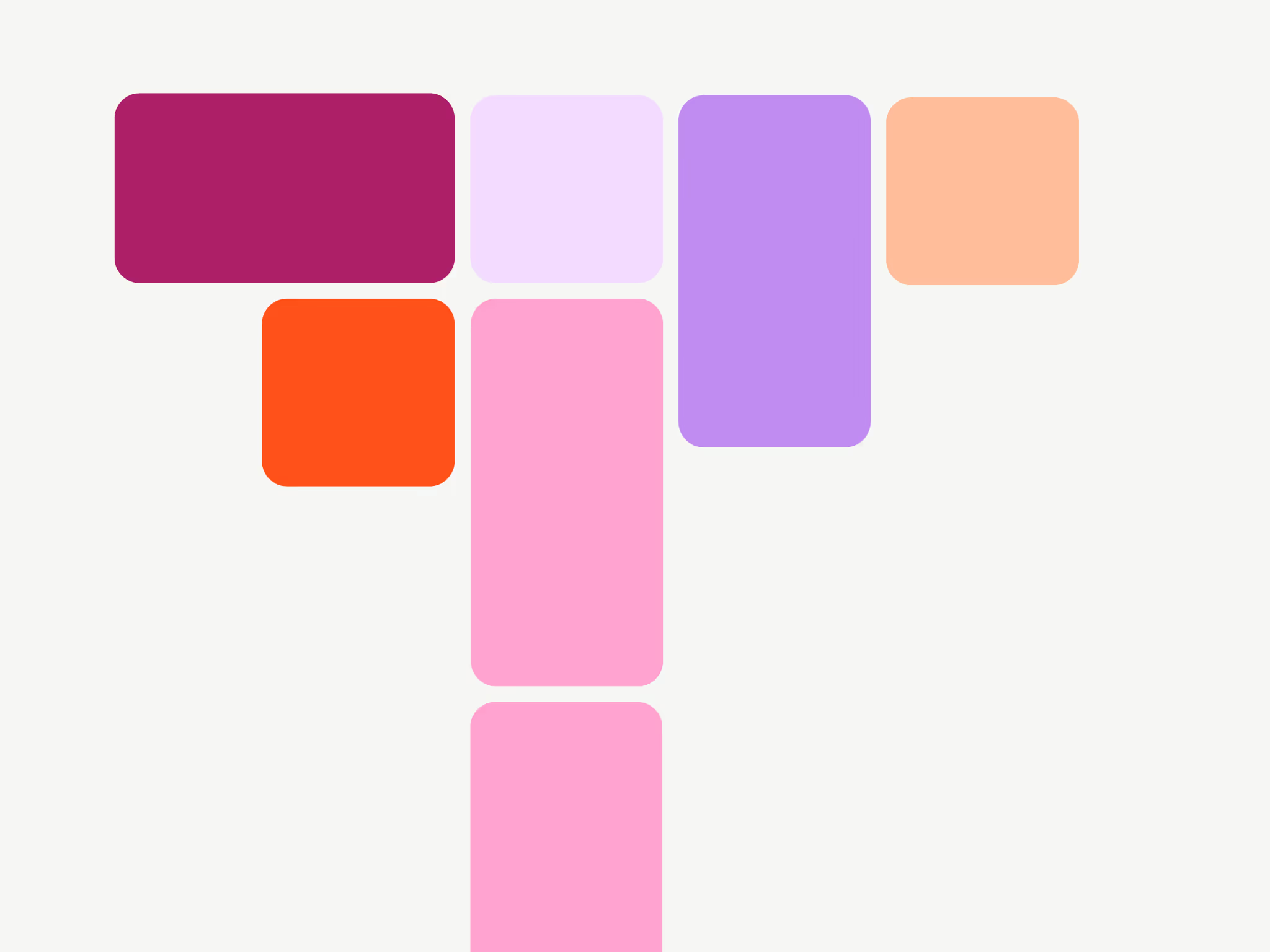Using influencer marketing to launch in a new market comes with a whole set of challenges. Some are expected, like finding the right creator partners. Others are less obvious, such as navigating vastly different cultural norms.
I’ll save you the trouble of learning the hard way: here are the seven most common challenges you will face – as per our survey of 35 influencer marketers who have launched campaigns in new markets – and the solution to each.
👉Want to master market expansion from A to Z? Learn everything you need to know from our complete survey findings.
Challenge 1: Finding the right influencers
Finding the right influencers is by far the biggest challenge marketers face in a new market – over 62% of our survey participants agree.
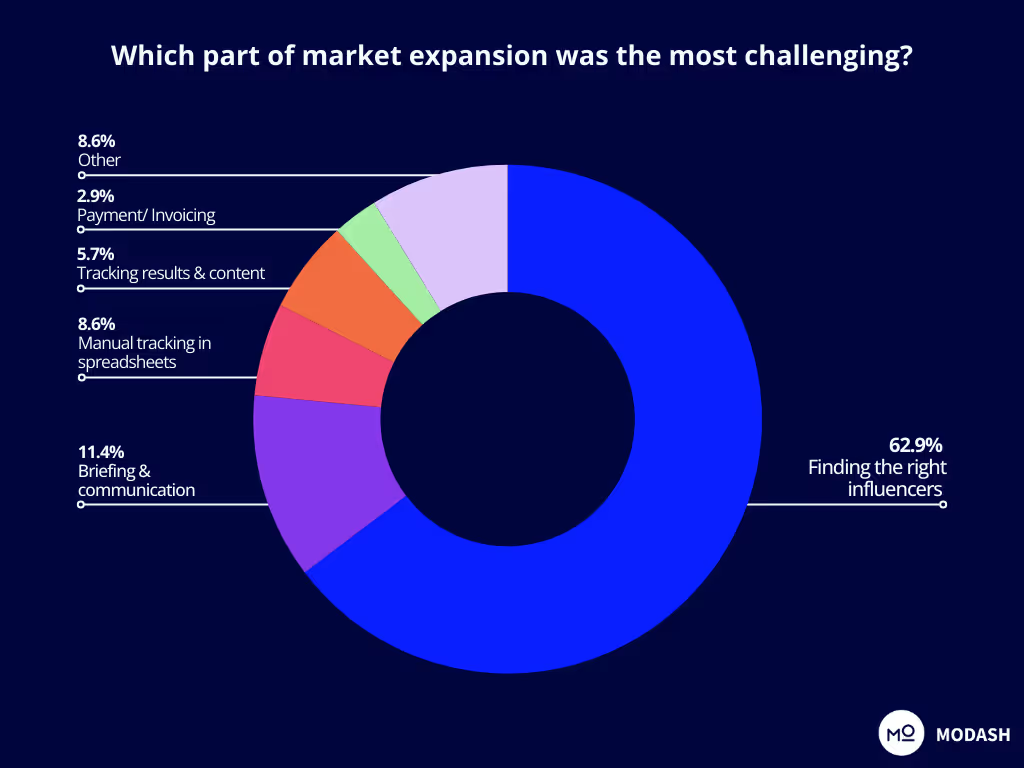
Why is finding creators in a new market so challenging? Because you can’t tell which ones have built trust with their audience, and you don’t know how your vetting criteria should adapt in a new context. Michael Todner elaborates:
You will better understand which influencers are trustworthy as you launch more campaigns in a new market. With time and practice, you’ll start to get the inside jokes, local news, and overall vibe. But what do you do in the beginning?
How to find the right influencers in a new market
Forty percent of respondents in our survey used influencer marketing software to find creators in a new market.
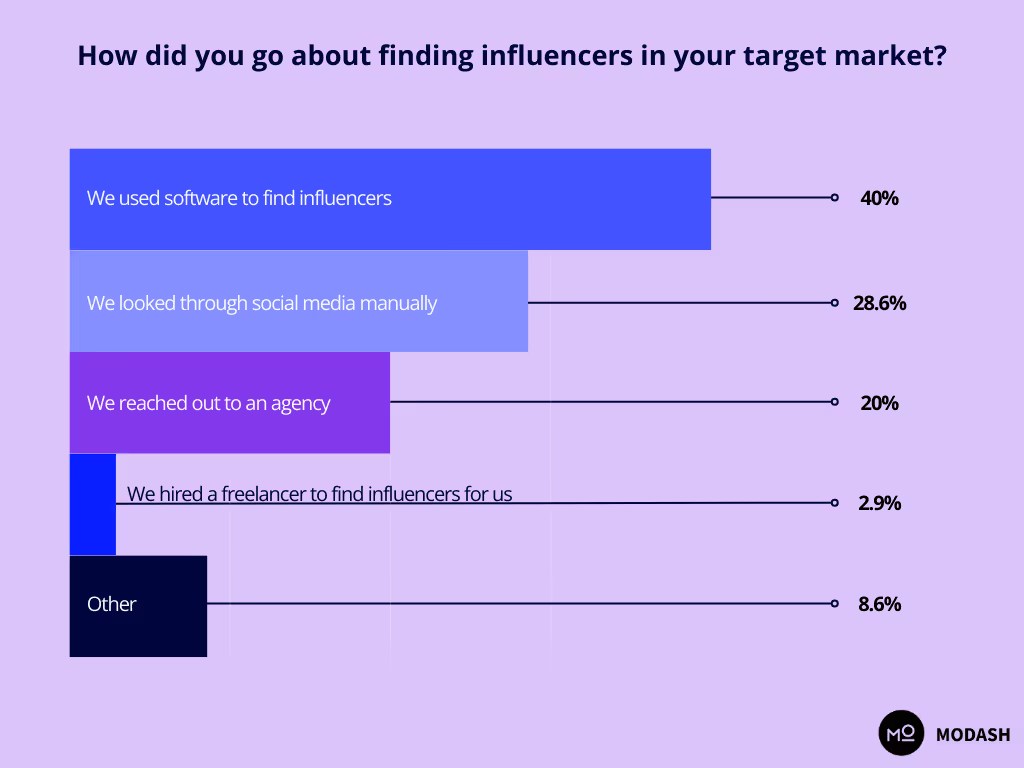
And it makes sense – using software is an efficient way to vet each creator for basic metrics like engagement rate, fake followers, and sponsored post performance. Using Modash, you can also dive deep into their audience demographics, follower growth, overall impressions, and more.
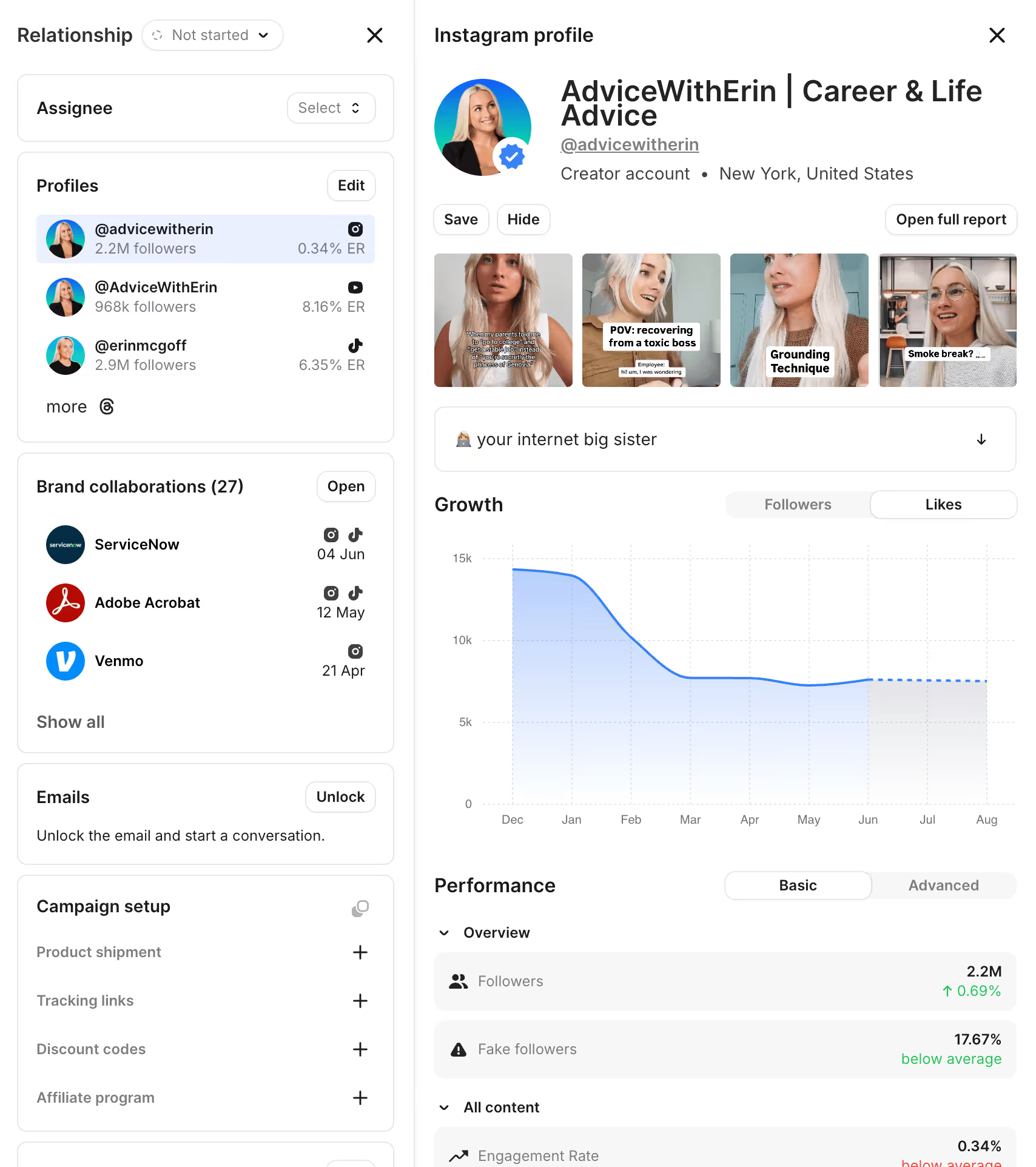
An important note: You will need to adapt your right-fit criteria while vetting creators in a new market. A standard engagement rate in your market will look different in other markets. So too will the influencer content. Valerija Somi agrees:
Using a tool alone might suffice if you’re launching in a new customer category or a culturally similar market. But if you’re expanding into a new territory where the societal norms, language, etc., are vastly different, it’s best to rely on local support. Hire local agencies or freelancers to help you find creators who are well-liked and trusted in that particular region. Rugile Paleviciute explains how valuable local knowledge is in specific markets:
Understanding the local culture’s nuances is time-consuming. You will eventually get the vibe the more you work in a new market, but you’ll take the longer route there. Julianne Kiider agrees:
Another benefit of having someone local on your side is that they help you build trust with influencers. When you’re the new brand on the block, creators might not want to take a chance on you yet. But if you have a trusted local agency on your extended team, influencers will be more willing to partner with you.
The bottom line: take the guesswork out of finding creators in a new market with the help of 1) software and 2) local agencies or freelancers.
Challenge 2: Understanding the culture of a new market
No two markets are the same. This is especially true if you’re expanding internationally in a market that’s completely different from yours (like from the US to India, for example). Fernanda Marques says it’s a mistake to have a universal influencer marketing strategy as opposed to one that adapts to new markets:
But the challenge is knowing what about your strategy needs to change. When you’re not living in the target market, how can you pick up on the cultural differences and adapt to them?
How to understand the culture of a new market
Fortunately, the solution is simple: hire a local agency to hold your hand as you navigate the waters of a new market. They will provide valuable feedback on your campaigns since they know what will work well and what won't with potential new buyers. Lucy Sergeeva agrees:
But what if you can’t afford to hire a local agency? Consider these alternatives:
- Ask your new influencer partners to provide feedback on your product and brand messaging. Trust that the influencers know their market best, and give them as much creative freedom as possible. After a few iterations, you’ll start picking up on what works well and what falls flat in the new market.
- Hire a local freelancer. Agencies can be expensive, but freelancers don’t usually burn a hole in your pocket. You can collaborate with freelancers on a contractual basis for a few months to learn the ropes of what works in a new market.
- Give yourself more time to prepare. The last resort is to DIY it. If you’re going that route, spend ample time researching and testing in the new market before you start launching influencer campaigns.
⚠️Note: Don’t get burned by partnering with someone who doesn’t know what they’re doing. Before hiring a local agency or a freelancer, check for referrals in your network, get on a call, and ask for past references.
Challenge 3: Adapting brand messaging without compromising integrity
When you research the new market, take note of what messaging resonates with consumers. Buyers in different locations or segments might prefer different products or see different values in your product based on their culture, which means you have to adjust how you’re promoting your brand. No wonder over 65% of marketers in our survey said they adapted their messaging when expanding to a new market.
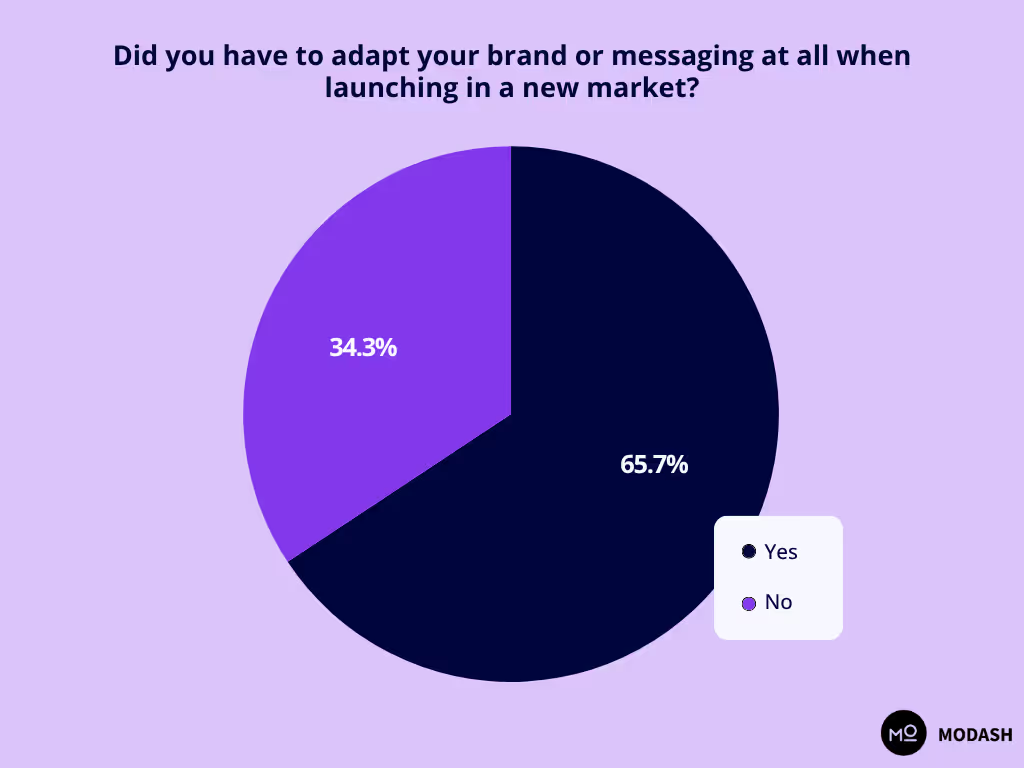
The challenge is not just in adapting your messaging, but also in maintaining your brand integrity. You have to decide which of your core messages are non-negotiable versus which ones you can be flexible with. Leslie Belen elaborates on the struggle to find a balance:
It’s like walking a tightrope: you want to cater to your new buyers but don’t want to lose what makes your brand unique.
How to balance your messaging without compromising the uniqueness of your brand
No matter the market, your messaging around brand values and USP should remain consistent. Be open to customizing everything else – like your products’ marketing descriptions, brand tone, etc. Abdullah Khan explains with an example:
Don’t designate too many non-negotiables, either. Keep in mind that you need to tailor a considerable amount based on the market you’re expanding to – especially if you’re launching internationally. Lee Drysdale explains the consequences of a lack of a localized strategy:
Ultimately, maintaining your brand integrity comes down to 1) deciding on non-negotiables (though not too many) and 2) aligning your messaging with the new market.
Challenge 4: Adapting to new content formats and social media platforms
Messaging is one thing, but new markets also have different preferences for platforms and content.
For instance, if your home market primarily uses TikTok to discover new products but your new market prefers YouTube, you’ve got to learn YouTube influencer marketing from top to bottom – a huge challenge, because success is measured and reported on differently across platforms. Joshita Dodani agrees:
And sometimes, your new market prefers a different content type (even if the social media platform remains the same). Fernanda shares her experience of launching Kanpai Foods in a new market:
Additionally, Valerija found that African markets preferred more overtly promotional content. Rugile discovered that in Japanese markets, it’s common for creators to not show their faces on camera. Your new market, too, will have preferences that require some level of understanding and adaptation.
How to adapt to new content formats and social media platforms
Before you can adapt, you need to know:
- the most used social media platforms in your new market (specifically for your target audience)
- the kind of content that does well in this market
Here’s how to do your homework:
- Research papers can tell you where your new target audience spends most of their time and what kind of content nudges a purchase.
- Go deeper with practical experience by using a VPN (if you’re in a different physical location) and scrolling the feeds yourself.
- If you’re working with a local agency or freelancer, ask them about the most widely used social channels and popular content formats.
- Lastly, give your new influencer partners creative freedom with a loose brief. Based on their performance, you’ll be able to understand what kind of content garners the best results. Abdullah followed this approach himself:
At first, learning new social channels and content types can be a struggle. But with perseverance, you’ll soon understand the buyer psychology of your new market.
Challenge 5: Communicating with different kinds of creators
Influencer rates, workflows, and expectations change across markets. Victor Wiśniowski elaborates with an example:
In some markets, influencer gifting might not be a common collaboration type. In others, influencer communication works better on different channels. Some cultures are more lax with deadlines than others.
In short, you’ll encounter a wide range of creator expectations as you expand your market.
How to prepare for collaborating with different kinds of creators
If you’ve got local help who has experience working in your home market as well as your new market, they’ll know what differences to flag right away.
And if they don’t know about your home market, it’s worth getting on a call to lay out your usual process and workflows for influencer collaborations. You can prompt your local partner to highlight how their working expectations differ and where your processes might face hurdles, especially with creators in the new market.
If you’re taking the DIY route, get on a call with your influencer partners to discuss the same issues. Be open to feedback and tweak your workflows wherever possible to meet your creators in the middle.
Lastly, build extra time in your calendar between influencer briefing and content delivery to ensure you can fix any hiccups, whether it’s a misunderstanding of the guidelines or navigating changes in influencer content.
Don’t expect to replicate your current workflows and processes – that will only lead to disappointment and frustration. Instead, be open to influencer feedback and note any struggles you encounter. After a few collaborations in the new location, you will have laid out a solid process that works for your new market.
Challenge 6: Campaign fulfillment takes longer than usual
If you’ve been running influencer campaigns for a while, you might be used to wrapping up a collaboration within a certain time frame. After all, you’ve mastered the process at home and likely have tons of long-term influencer partners who ace your expectations.
But a new market isn’t as smooth sailing, at least at the start. Hear it from Greta Zacchetti:
Multiple influencer marketers in our survey reported that their strategy took longer than expected in a new market. This delay can cause stress and frustration – especially if you’ve planned to use your influencer content to make a splash in the new market.
How to avoid delays when launching in a new market
The simplest way to avoid any timeline stress is to pad your deadlines. If you think a task will take one week, allot it an additional 3–6 days. This includes giving creators earlier submission deadlines so you can flag any changes you need in their content without rushing the process.
It’s also worth taking a significant amount of time just to prepare for the launch. In our survey, over half the marketers took more than three months of prep time in order to break into a new market.

If you’re expanding internationally, you might want to start preparing 9–12 months in advance. It doesn’t hurt to have some buffer time in your back pocket, but it will definitely hurt to deal with delays. So, err on the side of caution.
Tamara Torrecillas suggests also factoring in a learning curve:
Lastly, expect some things to go wayward and cause delays in your new market. Shipments might reach influencers late, or a creator might send over the wrong file – these are part of the territory, even at home. Expecting them will prepare you to think on your feet for workarounds.
Challenge 7: Stakeholders expect conversions quickly
When you’re launching in a new market – especially internationally where the culture is very different – take your time with building brand awareness. (After all, no one knows about your brand yet, and you might be introducing an entirely new product category for the target market.) Just over 57% of marketers in our survey focus on brand awareness to build trust before launching a sales campaign in a new market.
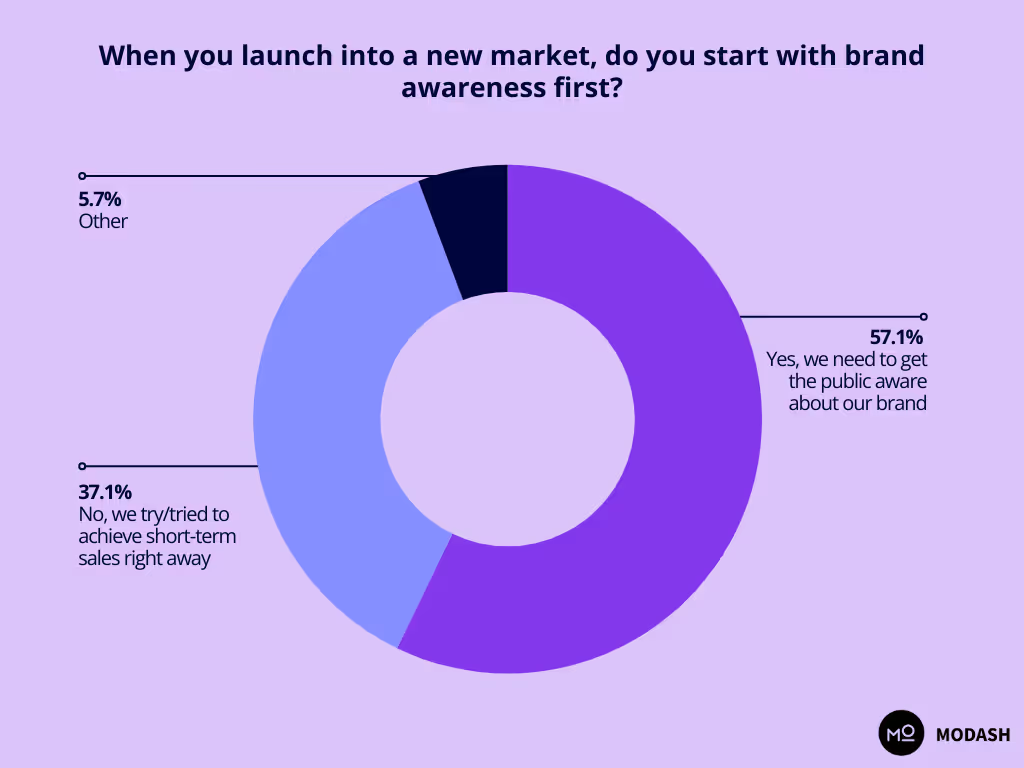
But stakeholders often ask for more tangible results than “brand awareness” to justify the influencer marketing expense. Greta explains the quandary:
How to balance stakeholder expectations
There are various ways you can manage stakeholder expectations to avoid rushing into sales mode:
- Track your brand awareness efforts. Brand awareness is more tangible than your stakeholders believe. Create brand awareness reports on website visits, link clicks, engagement, freebie downloads, etc. This will help you build trust with stakeholders on the ROI of influencer marketing, even if it isn’t bringing in direct sales just yet.
- Put a deadline on how long you’ll focus on brand awareness. Your stakeholders will understand why you want to focus on brand awareness – what worries them is how long it’ll take to see their investment back. The solution? Share a timeline of how long you plan to focus on brand awareness initiatives. For Fernanda, that timeline is three months:
- Supplement your influencer marketing with other marketing initiatives. Influencer marketing doesn’t exist in a silo. Ask help from adjacent departments to increase the impact of your influencer content – like running paid ads, using influencer content on product tutorials or email marketing, etc. You can repurpose influencer content in tons of ways (if you have the usage rights) to justify your budget.
In the beginning, you can focus solely on brand awareness and conduct paid partnerships. But as more and more collab posts go live, add affiliate marketing to please your stakeholders, report better results, and allow your influencer partners to earn more from their efforts via performance-based incentives like coupon codes or UTM links. Win-win-win, if you ask me.
New market, new rules
The core theme of all the challenges is understanding the differences in a new market – whether that’s managing influencer expectations, gauging buyer preferences, or adapting brand messaging.
What works on your home turf may not even move the needle in a new market. You gotta hand over old habits at the border.
But one thing can move markets with you: Modash. It will help you find influencers, vet their profiles, outreach at scale, track creator content, and manage payments – without pulling your hair out.
All in one tab.
Regardless of which market you’re operating from.
Don’t believe the hype? Try it for free for 14 days. No credit card needed.

















